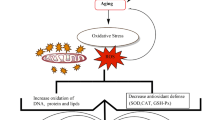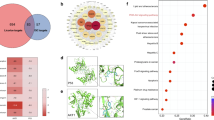Abstract
Objective
Honokiol is a phenolic compound isolated from the bark of Magnolia officinalis, a plant widely used in traditional medicine. Antimycin A, which inhibits complex III of the electron transport system, has been used as a reactive oxygen species generator in biological systems. In the present study, we investigated the protective effects of honokiol on antimycin A-induced dysfunction in osteoblastic MC3T3-E1 cells.
Materials and methods
Osteoblastic MC3T3-E1 cells were pre-incubated with honokiol before treatment with antimycin A, and markers of mitochondrial function and oxidative damage were examined. In addition, the effects of honokiol on the activation of PI3K (phosphoinositide 3-kinase) and CREB (cAMP-responsive element-binding protein) were examined in MC3T3-E1 cells.
Results
Honokiol significantly (P < 0.05) increased cell viability and calcium deposition and decreased the production of ROS in the presence of antimycin A. Moreover, pretreatment with honokiol prior to antimycin A exposure significantly reduced antimycin A-induced mitochondrial membrane potential (MMP) dissipation, complex IV inactivation, nitrotyrosine formation, and thioredoxin reductase inactivation. Honokiol also induced the activation of PI3K and CREB inhibited by antimycin A, which demonstrates that honokiol utilizes the PI3K and CREB pathway to augment metabolic activity inhibited by antimycin A.
Conclusion
Honokiol may reduce or prevent osteoblast degeneration in osteoporosis or other degenerative disorders.





Similar content being viewed by others
References
Cooper C, Melton LJI. Magnitude and impact of osteoporosis and fractures. In: Kelsey J, editor. Osteoporosis. San Diego: Academic Press; 1996, p. 419–34.
Brouillet E, Jenkins BG, Hyman BT, Ferrante RJ, Kowall NW, Srivastava R, Roy DS, Rosen BR, Beal MF. Age dependent vulnerability of the striatum to the mitochondrial toxin 3-nitropropioni acid. J Neurochem. 1993;60:356–9.
Smith TS, Bennett JP Jr. Mitochondrial toxins in neurodegenerative diseases: In vivo brain hydroxyl radical production during systemic MPTP treatment or following microdialysis infusion of methylpyridinium or azide ions. Brain Res. 1997;765:183–6.
Fiskum G, Rosenthal RE, Vereczki V, Martin E, Hoffman GE, Chinopoulos C, Kowaltowski A. Protection against ischemic brain injury by inhibition of mitochondrial oxidative stress. J Bioenerg Biomembr. 2004;36:347–52.
Dawson TL, Gores GJ, Nieminen AL, Herman B, Lemasters JJ. Mitochondria as a source of reactive oxygen species during reductive stress in rat hepatocytes. Am J Physiol. 1993;264:C961–7.
Garcia-Ruiz C, Colell A, Morales A, Kaplowitz N, Fernandez-Checa JC. Role of oxidative stress generated from the mitochondrial electron transport chain and mitochondrial glutathione status in loss of mitochondrial function and activation of transcription factor nuclear factor-kappa B: studies with isolated mitochondria and rat hepatocytes. Mol Pharmacol. 1995;48:825–34.
Squires RF, Ai J, Witt MR, Kahnberg P, Saederup E, Sterner O, Nielsen M. Honokiol and magnolol increase the number of [3H] muscimol binding sites three-fold in rat forebrain membranes in vitro using a filtration assay, by allosterically increasing the affinities of low-affinity sites. Neurochem Res. 1999;24(12):1593–602.
Liou KT, Shen YC, Chen CF, Tsao CM, Tsai SK. The anti-inflammatory effect of honokiol on neutrophils: mechanisms in the inhibition of reactive oxygen species production. Eur J Pharmacol. 2003;475(1–3):19–27.
Watanabe K, Watanabe H, Goto Y, Yamaguchi M, Yamamoto N, Hagino K. Pharmacological properties of magnolol and honokiol extracted from Magnolia officinalis: central depressant effects. Planta Med. 1983;49:103–8.
Chiang J, Shen YC, Wang YH, Hou YC, Chen CC, Liao JF, Yu MC, Juan CW, Liou KT. Honokiol protects rats against eccentric exercise-induced skeletal muscle damage by inhibiting NF-kappaB induced oxidative stress and inflammation. Eur J Pharmacol. 2009;610(1–3):119–27.
Dikalov S, Losik T, Arbiser JL. Honokiol is a potent scavenger of superoxide and peroxyl radicals. Biochem Pharmacol. 2008;76(5):589–96.
Park J, Lee J, Jung E, Park Y, Kim K, Park B, Jung K, Park E, Kim J, Park D. In vitro antibacterial and anti-inflammatory effects of honokiol and magnolol against Propionibacterium sp. Eur J Pharmacol. 2004;496(1–3):189–95.
Quarles LD, Yohay DA, Lever LW, Caton R, Wenstrup RJ. Distinct proliferative and differentiated stages of murine MC3T3-E1 cells in culture: an in vitro model of osteoblast development. J Bone Miner Res. 1992;7:683–90.
Turrens JF, Boveris A. Generation of superoxide anion by the NADH dehydrogenase of bovine heart mitochondria. Biochem J. 1980;191:421–7.
Chance B, Seis H, Boveris A. Hydroperoxide metabolism in mammalian organs. Physiol Rev. 1979;59:527–605.
Balaban RS, Nemoto S, Finkel T. Mitochondria, oxidants, and aging. Cell. 2005;120:483–95.
Stambough JL, Brigghton CT, Iannotti JP, Storey BT. Characterization of growth plate mitochondria. J Orthop Res. 1984;45:235–46.
Wuthier RE, Chin JE, Hale JE, Register TC, Hale LV, Ishikawa Y. Isolation and characterization of calcium-accumulating matrix vesicles from chondrocytes of chicken epiphyseal growth plate cartilage in primary culture. J Biol Chem. 1985;260:15972–9.
Kroemer G, Reed JC. Mitochondrial control of cell death. Nat Med. 2000;6:513–9.
Dröse S, Brandt U. The mechanism of mitochondrial superoxide production by the cytochrome bc1 complex. J Biol Chem. 2008;283:21649–54.
Muller FL, Liu Y, Van Remmen H. Complex III releases superoxide to both sides of the inner mitochondrial membrane. J Biol Chem. 2004;279:49064–73.
van der Vliet A, Eiserich JP, Kaur H, Cross CE, Halliwell B. Nitrotyrosine as a biomarker for reactive nitrogen species. Methods Enzymol. 1996;269:175–84.
van der Vliet A, Hristova M, Cross CE, Eiserich JP, Goldkorn T. Peroxynitrite induces covalent dimerization of epidermal growth factor receptors in A431 epidermoid carcinoma cells. J Biol Chem. 1998;273:31860–6.
MacMillan-Crow LA, Crow JP, Kerby JD, Beckman JS. Nitration and inactivation of manganese superoxide dismutase in chronic rejection of human renal allografts. Proc Natl Acad Sci USA. 1996;93:11853–8.
Arner ES. Focus on mammalian thioredoxin reductases–important selenoproteins with versatile function. Biochim Biophys Acta. 2009;1790(6):495–526.
Zhong L, Holmgren A. Essential role of selenium in the catalytic activities of mammalian thioredoxin reductase revealed by characterization of recombinant enzymes with selenocysteine mutations. J Biol Chem. 2000;275:18121–8.
Gromer S, Urig S, Becker K. The Thioredoxin system—from science to clinic. Med Res Rev. 2004;24:40–89.
Myers CR, Myers JM. The effects of acrolein on peroxiredoxins, thioredoxins, and thioredoxin reductase in human bronchial epithelial cells. Toxicology. 2009;257:95–104.
Carpio L, Gladu J, Goltzman D, Rabbani SA. Induction of osteoblast differentiation indexes by PTHrP in MG-63 cells involves multiple signaling pathways. Am J Physiol Endocrinol Metab. 2001;281:E489–99.
Matsuo N, Tanaka S, Gordon MK, Koch M, Yoshioka H, Ramirez F. CREB-AP1 protein complexes regulate transcription of the collagen XXIV gene (Col24a1) in osteoblasts. J Biol Chem. 2006;281(9):5445–52.
Pawson T, Nash P. Protein-protein interaction define specificity in signal transduction. Gene Dev. 2000;14:1027–47.
Vivanco I, Sawyers CL. The phosphatidylinositol 3-Kinase AKT pathway in human cancer. Nat Rev Cancer. 2002;2:489–501.
De Rasmo D, Signorile A, Roca E, Papa S. cAMP response element-binding protein (CREB) is imported into mitochondria and promotes protein synthesis. FEBS J. 2009;276(16):4325–33.
Kelly DP, Scarpulla RC. Transcriptional regulatory circuits controlling mitochondrial biogenesis and function. Genes Dev. 2006;18:357–68.
Acknowledgments
This research was supported by the Basic Science Research Program through the National Research Foundation of Korea (NRF) funded by the Ministry of Education, Science and Technology (20110005020).
Author information
Authors and Affiliations
Corresponding author
Additional information
Responsible Editor: Liwu Li.
Rights and permissions
About this article
Cite this article
Choi, E.M. Honokiol protects osteoblastic MC3T3-E1 cells against antimycin A-induced cytotoxicity. Inflamm. Res. 60, 1005–1012 (2011). https://doi.org/10.1007/s00011-011-0360-3
Received:
Accepted:
Published:
Issue Date:
DOI: https://doi.org/10.1007/s00011-011-0360-3




